If your vehicle is equipped with an optional passive restraint system (SRS), the front seats are fitted with pretensioner seat belts. The use of these belts is similar to the use of conventional seat belts.
Warnings
(1) The waist band of the belt must always fit snugly around the hips and not the stomach. A seat belt that is too high increases the risk of injury to internal organs in an accident.
(2) The diagonal section of the seat belt should run approximately across the middle of the shoulder and never wrap around the neck. In this case, the belt tape should fit snugly against the chest.
(3) The seat belt must be properly adjusted. Failure to do so reduces the effectiveness of the overall safety system and increases the risk of serious injury in the event of an accident.
(4) The maximum protective effect of the seat belts and airbags is only achieved when the seats are properly adjusted. Set the seatback to the closest to the upright position and sit upright with your back pressed against the seatback.
(5) Every passenger in a car must wear a seat belt at all times. Children must be seated in the rear seat and, if necessary, in an optional child seat.
(6) Do not fasten a twisted seat belt as this reduces its effectiveness.
(7) Never fasten two people with one belt (including children). It is especially dangerous to fasten a child when he is sitting on your lap.
(8) Never carry more people in a car than there are seat belts.
Three-point safety belts with retractable mechanism
This type of belt does not require adjustment in length. After putting on such a belt, it automatically follows the movements of your body, but in the event of a sudden or strong jerk, the belt automatically locks to hold the person fastened by it.
Three-point safety belt with retractable mechanism (with automatic lock)
This type of belt acts like a conventional seat belt with a retractable mechanism. This type of belt does not need to be adjusted in length, because after putting it on it automatically follows the movements of your body. However, in the event of a sudden and/or severe collision, the belt will automatically lock to hold the person's body.
In addition to the crash lock function, this seat belt has a seat belt pretensioner that works in automatic child seat locking mode. To return the seat belt to a more comfortable emergency locking mode, wait until the vehicle has stopped, unfasten and fully retract the seat belt, then unbend it and re-fasten it.
Fastening seat belts
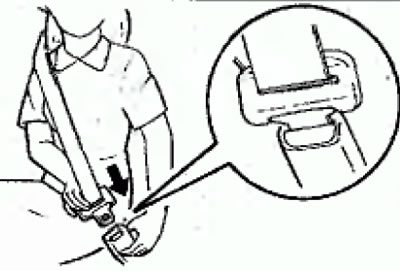
Grasp the buckle of the belt, gently pull the tape and put it over the chest through the middle of the shoulder. Insert the clasp into the slot of the corresponding lock until you hear an audible click.
Note. If the seat belt cannot be pulled out because it is locked, pull the belt firmly once and release it. After that, try again to smoothly pull out the belt.
Releasing the seat belt
To unfasten the seat belt, press the buckle button, while the buckle is pushed out of the socket under the action of the spring and the belt is fully retracted.
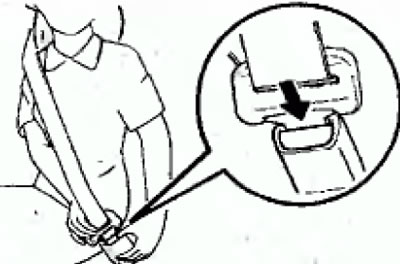
Note. Since the belt will retract automatically, hold the latch tab so that the belt retracts smoothly.
3-point seat belt for middle rear seat
Do not use the center seat belt of the third row seats with any tongue not fastened as this could result in serious injury or death in the event of sudden braking or an accident.
Fasten the rear seat center seat belt as shown in the illustrations.
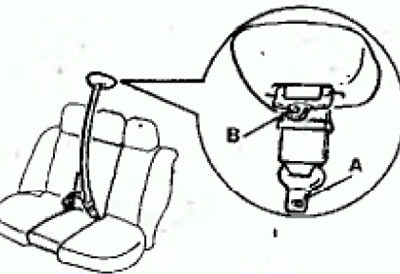
1. Pull out the waist belt and insert the latch tab (A) in black seat belt buckle (IN).
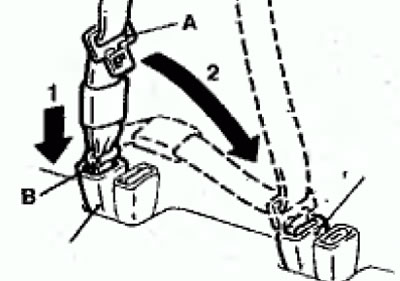
2. Insert the tongue firmly (WITH) in the red seat belt buckle (D).
If the rear seat center belt is not being used, position the latch tabs as shown in the illustrations.
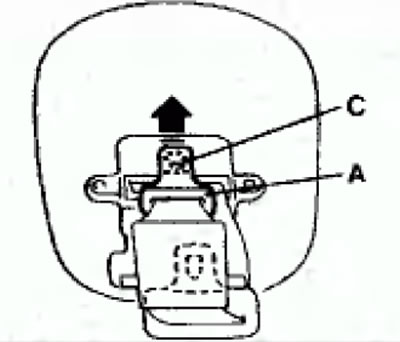
1. Gently pull the strap and insert the latch tab (A) (at the end of the belt) in a case with a label (WITH).
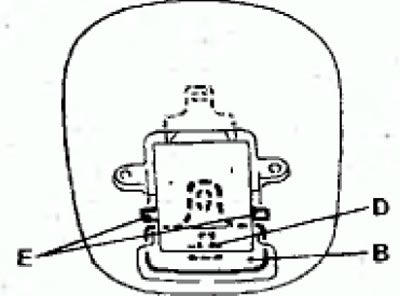
2. Align tongue (IN) labeled (D), then insert the hook (E) into the hole in the case and secure the tab in the appropriate position.
Lap belts
The lap belts must be adjusted beforehand. To do this, holding the bar at a right angle to the belt, tighten the belt as shown in the figure so that it fits snugly around the body.
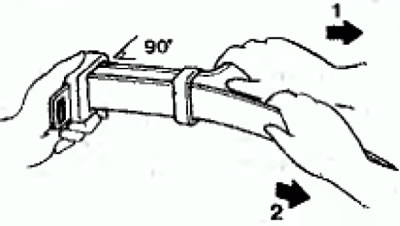
1. Tightening; 2. Weakening
Holding the strap (latch tongue) hand, insert it into the lock until it clicks.
Note. The buckle and placket of the central lap belt are marked with the inscription "CENTER". Before putting on the lap belt, be sure to pay attention to this marking.
Seat belt height adjustment (front seats)
Adjusting the height of the belt allows you to adjust the shoulder strap of the seat belt according to your height.
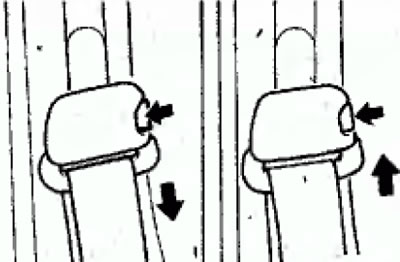
Press the button and move the slider with the brace down or up to such a position that the shoulder line of the belt is at the level of the middle of the shoulder, but in no case covers the neck. Release the button to lock the slider with the bracket.
